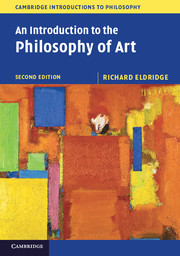Book contents
- Frontmatter
- Contents
- Acknowledgments
- Preface to the second edition
- 1 The situation and tasks of the philosophy of art
- 2 Representation, imitation, and resemblance
- 3 Beauty and form
- 4 Expression
- 5 Originality and imagination
- 6 Understanding art
- 7 Identifying and evaluating art
- 8 Art and emotion
- 9 Art and morality
- 10 Art and society: some contemporary practices of art
- 11 Epilogue: the evidence of things not seen
- Bibliography
- Index
- References
1 - The situation and tasks of the philosophy of art
Published online by Cambridge University Press: 05 June 2014
- Frontmatter
- Contents
- Acknowledgments
- Preface to the second edition
- 1 The situation and tasks of the philosophy of art
- 2 Representation, imitation, and resemblance
- 3 Beauty and form
- 4 Expression
- 5 Originality and imagination
- 6 Understanding art
- 7 Identifying and evaluating art
- 8 Art and emotion
- 9 Art and morality
- 10 Art and society: some contemporary practices of art
- 11 Epilogue: the evidence of things not seen
- Bibliography
- Index
- References
Summary
Who needs a theory of art?
For almost all people in almost all cultures, either the fact (as in dance) or the product (as in painting) of some commanding performance that is both somehow significant and yet absorbing in its own right (rather than as an immediate instrument of knowledge or work) has raised strong emotions. The dramatic rhapsode Ion, in Plato’s dialogue, reports that when in performance he looks “down at [the audience] from the stage above, I see them, every time, weeping, casting terrible glances, stricken with amazement at the deeds recounted.” Richard Wagner finds nothing less than salvation in the experience of art.
I believe in God, Mozart and Beethoven . . . I believe in the Holy Spirit and the truth of the one, indivisible Art . . . I believe that through this Art all men are saved, and therefore each may die of hunger for Her . . . I believe . . . that true disciples of high Art will be transfigured in a heavenly veil of sun-drenched fragrance and sweet sound, and united for eternity with the divine fount of all Harmony. May mine be the sentence of grace! Amen!
- Type
- Chapter
- Information
- An Introduction to the Philosophy of Art , pp. 1 - 24Publisher: Cambridge University PressPrint publication year: 2014

